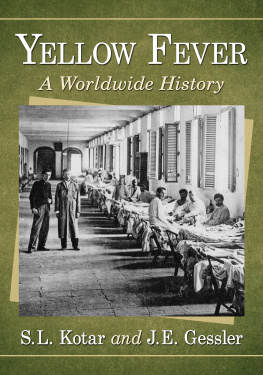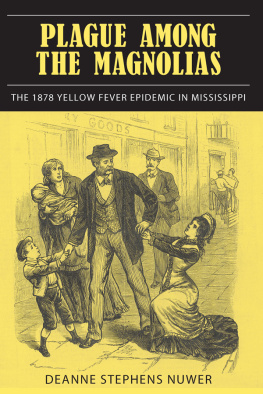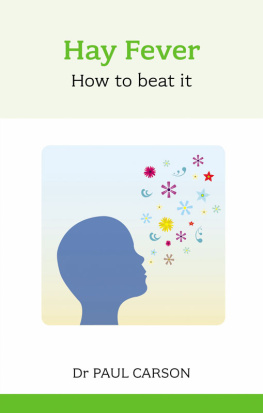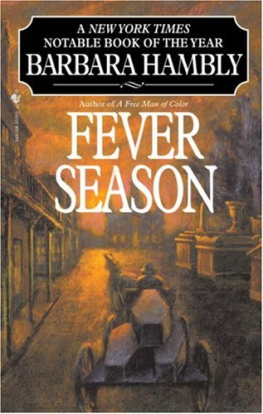Rich Mans War, Poor Mans Fight: Race, Class and Power in the Rural South During the First World War
The South, A Concise History, Vols. I and II
Tennesseans and Their History, with Stephen Ash and Paul Bergeron
Country People in the New South: Tennessees Upper Cumberland

Contents
September 1878
When those who lived through the epidemic tried to describe it, they talked about the sudden, eerie quiet. Built on high bluffs over the Mississippi, Memphis, Tennessee, was the only major urban center between St. Louis and New Orleans and the de facto commercial capital of a rural hinterland encompassing parts of Tennessee, Arkansas, and Mississippi. Although small compared with the nations largest city, with a population of roughly fifty thousand to New Yorks one million, Memphis was about twice the size of Nashville, the state capital, four times the size of Little Rock, Arkansas, and ten times the size of Jackson, capital city of Mississippi. Half the population had fled upon the outbreak of yellow fever, but an estimated twenty thousand remained. You would think that many people would produce noise sufficient to demonstrate their presence, but the voices we have from Memphis in the summer of 1878mostly doctors, nurses, and journalistsagree that the city felt abandoned.
A young journalist described the empty streets on a Sunday, the silence broken at long intervals by the slow passage of a mule pulling a vacant streetcar. A nurse from Texas named Kezia DePelchin wrote of the waterfront district, The large stores and warehouses on Front St. were closed. A woman with a few apples to sell on one block and two children sunning themselves on the steps of a large building on another block were all the signs of life. From the high bluff over the water, no curling smoke heralded the approach of a steamer, it was calm, unruffled by an oar, as when DeSoto first gazed in wonder and admiration on
That was how Memphis seemed to the people who stayed behind during the great yellow fever epidemic of 1878. On the other hand, the few individuals who came into the city, who defied warnings and common sense on errands of mercy or profit, talked about the stench. They said that you could smell Memphis from several miles away.
From august to October 1878, the people of Memphis suffered through an experience unique in American history. Yellow fever is a viral hemorrhagic fever passed from human to human by mosquitoes. Although mild cases produce flu-like symptoms, at its worst yellow fever is comparable to Ebola. The virus strain that caused the 1878 epidemic was extremely virulent. The fever spread up the Mississippi Valley from New Orleans to Illinois and killed an estimated eighteen thousand people. But it was Memphiss plight that riveted national attention. At least two thirds of the people in Memphis contracted the fever, and about one quarter died, more than five thousand in all. The mortality rate for African Americans was around 10 percent, but the disease was even more dangerous for the white population, where the mortality rate was as high as 70 percent. People ran fevers with temperatures over 105 degrees. In their delirium they stripped, ran naked into the streets, or crawled off to hide in back rooms. Victims in the late stages of the disease vomited up a black, viscous liquid containing coagulated blood; their skin turned bronze. So many people died so quickly that the bodies had to be buried in trench graves.
Histories of epidemics tend to follow a couple of patterns. One is the victory of science theme. In this formula, a disease kills a large number of people but is eventually brought under control by scientists who discover its etiology and use that knowledge to either cure it or stop it from spreading. The other formula asks what impact the disease had on something human beings were doing: making war, building cities, colonizing countries, organizing public health services. Here the emphasis is on disease as catalyst for human action. The way that we construct epidemic narratives, whether fictional or factual, is suspiciously comfortingfor us, not for people who live through such disasters. See, we say, things got better! We learned from this! Thus we whistle past the graveyard.
Although scientific research eventually led to the eradication of yellow fever in the United States, this book is not about that victory. Major Walter Reeds team of U.S. Army doctors did not discover that mosquitoes spread the fever until 1901. Once the method of transmission was understood, it was relatively easy to stop the fever. However, to telescope the 1878 epidemic and Reeds 1901 triumph, thus providing a happy ending, is to falsify the lived experience of the epidemic. The orphaned children of Memphis were adult men and women by 1901. The mass graves along the banks of the Mississippi had long since grown green. Those aging adults who had survived the epidemic must surely have been happyand astonishedto finally understand how the disease was transmitted and hopeful about eliminating it. It is hard to believe, however, that the new knowledge eased the old grief. What had happened to the city in 1878 could not be undone by any team of army doctors.
What follows is no scientific romance. Instead, this story of what happened in Memphis during the fever season of 1878 is informed by the most basic of questions: What was it like to live through that? Our focus here is on personalities and what the people of 1878 would have called, simply, character.
In extreme peril, surrounded by death and squalor, living on the bacon and coffee supplied by the nations charity, people in Memphis remained fascinated by character. They were most disconcerted to find that neither heroism nor villainy could be predicted by public standing, gender, or race. Upstanding citizens abandoned their families, and prostitutes and sporting men stepped up to care for the sick. White elected officials deserted their posts, but black militiamen stood fast as guardians of the city. Nurses risked their lives in houses full of pestilenceor robbed those houses and took off with bags full of loot. Some religious leaders left their flocks to die without spiritual comfort; others martyred themselves nursing the sick. The epidemic turned all common categories of trust and honor upside down and reduced good and evil to the most basic questions: Do you leave your people to die, or do you help?
To understand what happened in Memphis, a little natural history is in order.
Yellow fever is caused by an arbovirus of the genus Flavivirus; arbovirus indicates that the virus is spread by an arthropod (insect) vector. In the case of yellow fever, the viruss natural habitat is high in the canopies of West African rain forests, where Aedes mosquitoes such as Ae. africanus and Ae. simpsoni breed. After mating, female mosquitoes must consume blood in order to lay eggs. In the rain forest, the mosquito gets that blood by feeding on monkeys. Fortified by her blood meal, the female then deposits between one hundred and two hundred eggs on the sides of a hole in a tree filled with rainwater, typically going from pool to pool and tree to tree to spread the egg batch around. She does not mate again, but can keep on laying eggs, one batch per feeding, up to five times. In a life span of two to four weeks, therefore, a female Aedes mosquito can produce as many as a thousand eggs. The eggs are quite durable. They can withstand desiccation for months and will still hatch with the return of water, as when fresh rain fills their tree hole. In the tropics, the mosquitoes develop from eggs to larvae to pupae to mosquitoes in about a week, although the mosquitoes may stay in the larval stage for months at lower temperatures. The








